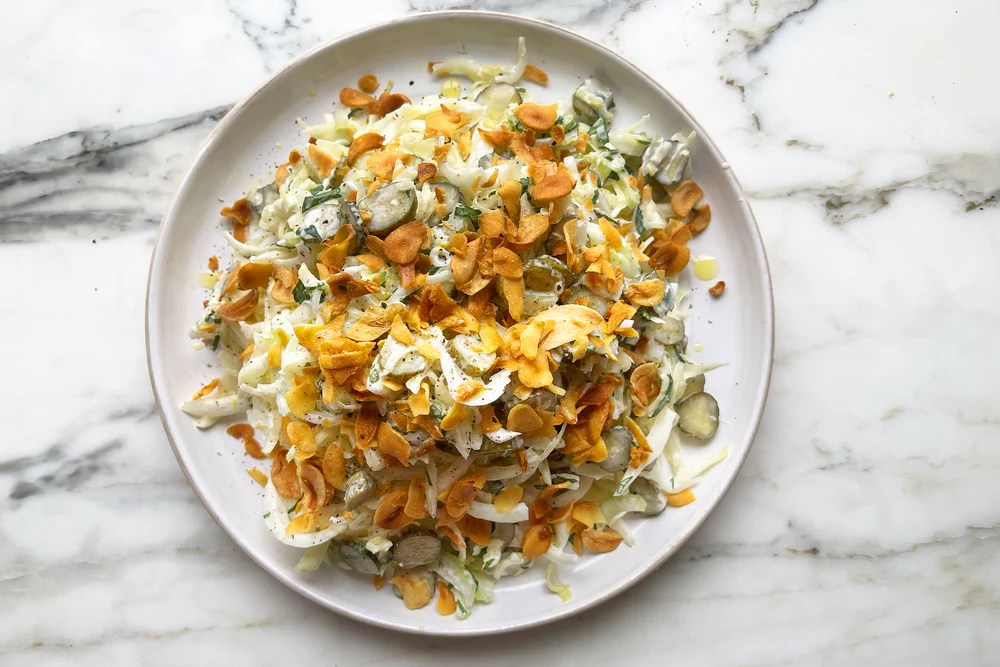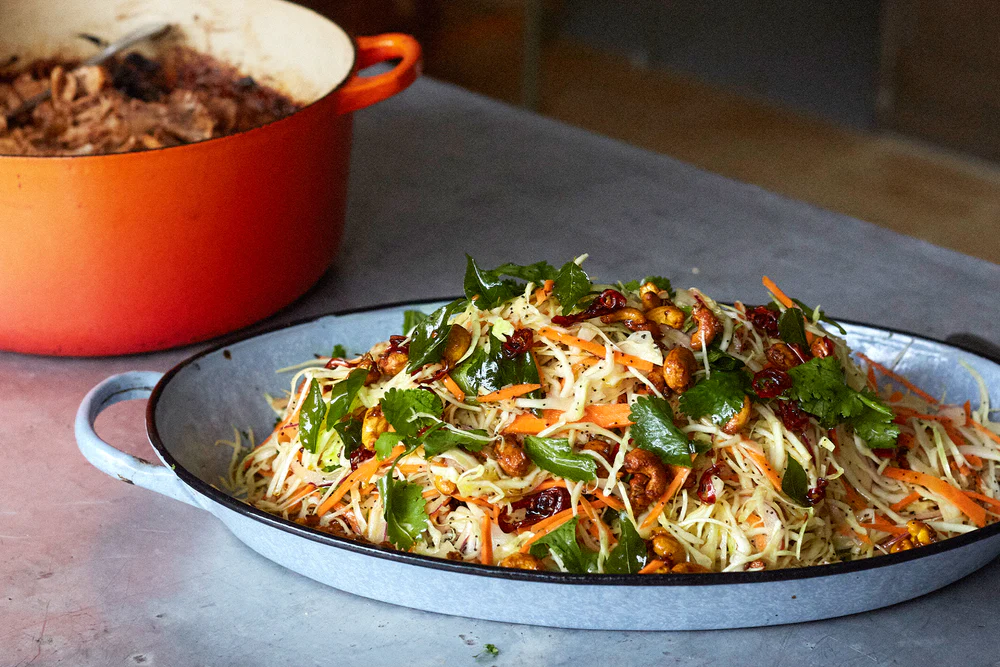"Like many other culinary words – carpaccio, confit, trifle – its meaning has broadened, and now cabbage may not even be present at all."
Nigel Slater

I'm not a huge salad fan, and definitely not a coleslaw fan. I think I have only made one once, but to be honest I was actually surprised at how good it was. Which is probably because my previous experience with coleslaw had been in packaged sandwiches, and as mass-produced sides in cheap eateries and food halls. However, prompted by a large selection of delicious looking slaws in the current Coles Magazine I decided that I should really look into it. After all summer is approaching in fits and starts which means salad.
Coleslaw however is a winter thing from a wintry country - Holland. I mean it's cabbage - and I now know that the one thing that everyone agrees on is that a coleslaw has to have cabbage - well it's original name - 'koolsla' is Dutch for cabbage salad. And cabbages are a winter vegetable, even though you can get them all year round. But why would you eat salad in winter? Well my current two favourites Nigel and Ottolenghi have marginally romanticised reasons:
"There is much that appeals about the crude crunch of a winter slaw, white, purple and moss green, eaten under a grey and watery sky." Nigel Slater
"meet the weather head on with a riot of colour, an abundance of freshness and the wake-up call of citrus fruit ... They’re like the friend who opts for a bracing swim over a hot bath, the one who wears a vibrant winter coat amid the sea of black and grey." Ottolenghi
Maybe it's just another form of Nigella's attempts to evoke summer through the food we eat, whatever the time of year. Although it's not quite the same because the ingredients are wintry. It's the concept that is summer. So yes - forever summer with Nigella.
It's an old dish - some say as old as the Romans, but the accepted origin story is Holland in the eighteenth century when it was a simple salad of cabbage with a vinaigrette kind of dressing. Dutch immigrants took their salad to America - I found a recipe in my old The American Heritage Cookbook:
"1 small head green cabbage; 1/2 cup double cream or commercial sour cream; 2 dessertspoons sugar; 1 teaspoon salt; 1/4 teaspoon pepper; 2 dessertspoons cider vinegar
Shred cabbage very fine (1 head should make about 1 quart when shredded). Mix cream with all remaining ingredients, add the cabbage, and toss gently until coated. Serve immediately, otherwise salad will become limp and soggy."

2 dessertspoons of sugar?! Even back then the Americans had a love affair with sugar. It's an early recipe that is a sort of a halfway house between the original vinaigrette kind of recipe and the traditional mayonnaise dressing that exists today - as in Martha Stewart's recipe for Traditional coleslaw, although even she hangs on to a bit of vinegar and sour cream in addition to the mayonnaise. It seems to have been the Americans who added the mayonnaise - invented in the eighteenth century and then exported it to the world. There seemed to be almost a universal agreement that the classic coleslaw that we know today was basically shredded cabbage, carrot and onion with a mayonnaise dressing. Martha Stewart drops the onion - as do many others, with some saying the taste of raw onion is too strong.
Today, of course it's anything goes, which is where I began, with Coles' "slaws inspired by classic salad combos". And here I will digress a tiny bit, as I did the other day with my other Coles, pepper beef recipe from Emma Knowles. This set of slaw recipes comes from Jessica Brook - another name that I recognised from here and there, so I looked her up.

Here she is with her current business partner, the food stylist Steve Pearce, responsible for virtually all of Donna Hay's food styling in her magazines for over a decade. It seems that he and Jessica have teamed up as a freelance company called Sage Creative Co. from which they work for virtually all of the prestigious foodie magazines. As they both have in the past. Jessica is a trained chef, has worked as an editor, a recipe developer, a stylist ... And isn't it good that Coles does acknowledge who is responsible for the recipes within it's magazine, even if it is in tiny print in the fold of the magazine? Woolworths, on the whole, does not.

This is the slaw that first caught my eye - and as you can see it is not traditional. Tomatoes? This one has an Italian slant - Italian-style slaw with basil and crispy prosciutto. The dressing is olive oil and lemon juice with honey and the vegetables include fennel as well as those tomatoes and a sprinkling of capers, basil, and Parmesan. Very Italian. I may well have a go at that one in the not too distant future. The other four recipes are equally tempting - Greek salad slaw - olives, cucumber, oregano and fetta; Waldorf slaw with fennel - a nod to the Americans with walnuts, mayonnaise and mustard; Rainbow slaw with ginger-soy dressing - representing the Asian slant that many slaws are featuring these days; Purple slaw with grapefruit vinaigrette and goat's cheese - a bit fruity which is another trend with apples, cranberries and grapefruit.
All of which are fairly representative of the various trends that you will find in the slaw world. Interestingly when I checked out my other really American book - Bert Greene's Greene on Greens, he introduced four slaw recipes by saying:
"I have been collecting cole slaw recipes since I was old enough to shred a cabbage and spare a thumb. Out of several hundred renderings, good sense bids me narrow down the list to the quartet that follows."
The quartet that followed also all had a geographical placement - the first being Mary Surina's Yugoslavian slaw which consisted of shredded cabbage which then had some hot boiled potato added and mashed in and finished off with a fairly standard vinaigrette. In some ways the weirdest instance of a slaw that I came across. Mashed potato?
Now Bert Greene is long dead and was writing back in the 80s, but even then it is obvious that people were digressing from the traditional slaw. Today, of course as Tony Naylor of The Guardian's now defunct How to Eat column said:
"After combining cabbage and mayo, you are free to improvise within rational boundaries – boundaries that the world repeatedly oversteps." Tony Naylor
So I looked to see what Ottolenghi and co had come up with. because they are always extending the boundaries.
It begins with his take on a traditional Coleslaw; and continues with Lime and poppyseed slaw with curry leaf oil - ending with Pear and apple slaw with mustard and watercress which has no cabbage in it at all, and which to me indicated that the definition of a modern slaw is not a salad of shredded cabbage and mayonnaise but a plate of shredded things with a dressing of some kind:

Which is demonstrated by these four salads in an Ottolenghi article on Winter salads and slaws in The Guardian, only one of which - Hispi cabbage and kalette slaw in the top right-hand corner is called a slaw. And yet the rest are all plates of shredded things. The definitions, it seems, are becoming increasingly blurred, so that people like Nigel Slater can say:
"The idea of gummy mayonnaise and the traditional coleslaw doesn't really enter into my head anymore. ... What we need is a slaw that dazzles rather than depresses." Nigel Slater
And so you get all those extra things thrown in - including cheese of various kinds, which at least one writer said was a complete no no for a slaw. But is this a bad thing? Indeed is there such a thing as an 'original' recipe? There might be for something like Peach Melba for example, because it was created for a specific occasion by a specific chef, but for most of our 'classic' dishes there is no 'ur' recipe. The Dutch settlers along the Hudson River in 1785 who made salads reminiscent of their faraway homeland, from the cabbage they grew beside the river, would surely not mind seeing what the chefs of today are doing with their original idea. Surely they would be flattered.
I realise I have also not mentioned that another variation is how that cabbage is treated. Some just slice and dress. (Slice in a machine, on a grater, by hand? - and how thin?) Others, sort of pickle it briefly in some form of acid, some massage salt into it as you do for sauerkraut, to make it wilt and I even saw one recipe that grilled it.
There are also lengthy dissertations on what you should eat it with - as a side, in a hamburger bun, with particular meats or fish ... With some saying it's obligatory with certain things:
“I won’t even sell someone a barbecue unless they get coleslaw. If they want a barbecue and they don’t want coleslaw, there’s something wrong with that person. It all goes together.” Wilber Shirley (Restaurateur)
Another feature of modern cuisine, is the fridge raid and the tendency of us all to make things out of the 'past their best' ingredients we may find there, and there are certain dishes that lend themselves to this - stir-fries, frittatas, quiches, risotto, pasta ... Not applicable to slaw however - well those things like capers and cornichons might find a place, but slaw has to be:
"Crunchy and wet, creamy and fresh, sweet and savoury, ... [so] this is not an opportunity to clear out the soggy, festering bottom of the salad drawer" Tony Naylor
I should tear out those Jessica Brook slaw recipes for my next barbecue, because I don't think I'm really tempted by the original version - although maybe Ottolenghi's classic one - it's got garlic chips on top.
Robert Carrier - an American - obviously thought it was a classic because he included it in his Great Dishes of the World. It was a fairly standard recipe. I wonder what he would have thought of some of the more extreme versions that exist today. I think he would have applauded, because he loved the fun of cooking and discovering new things to eat.
BACK THEN
October 30
2021 - Nothing - maybe the power was still out
2016 - Everything's coming up roses












Quite a lot of fuss about Cold Cabbage, whether it is a Classic or not!